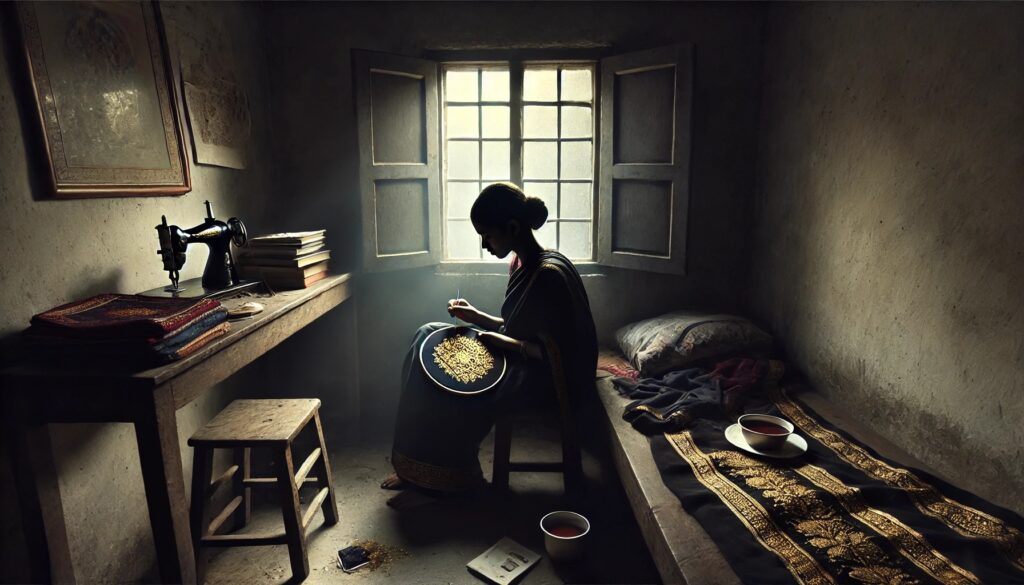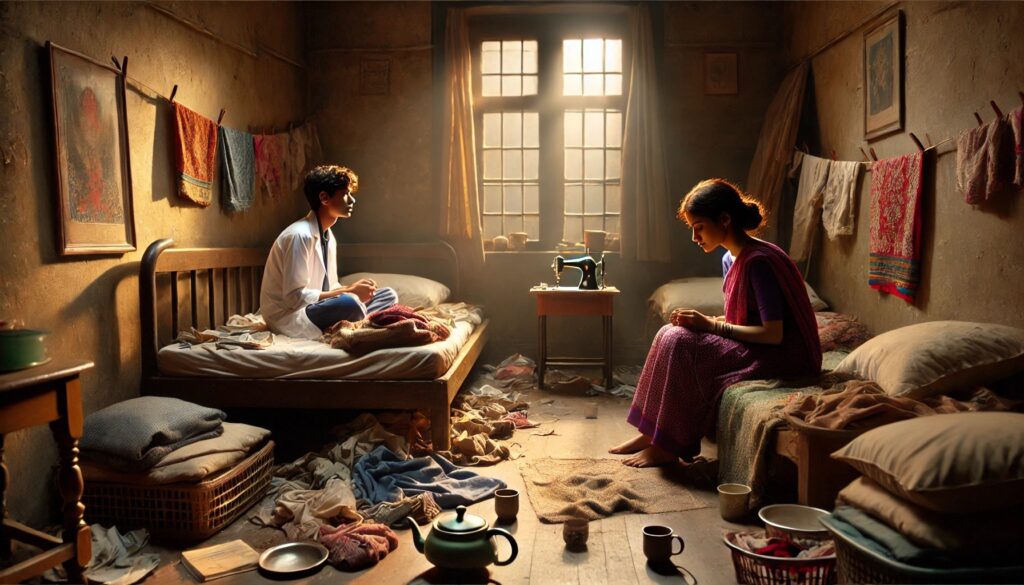A Silent Goodbye: Kavya’s Story

The room was small and cluttered, carrying the musty scent of books, ink, and old coffee.
The ceiling fan spun lazily, barely making a difference in the heavy afternoon air.
Amrita paced back and forth, her lips moving silently as she muttered her medical notes under her breath.
The floor was littered with open textbooks, half-written notes, and a forgotten tumbler of tea, now cold.
“The right lung consists of three parts…” she murmured, rubbing her temples. “Upper part… fourth rib… lateral surface…”
She had been at this for hours. The upcoming exams loomed over her like dark clouds, pressing on her nerves.
She stopped suddenly, turning to look at the frail figure sitting by the window.

“Kavya,” she called.
The girl did not look up immediately.
Her thin fingers continued to move, carefully weaving a golden border onto a blouse.
Her head was slightly bent, her shoulders hunched, and only the soft rustle of fabric and the distant hum of the outside world filled the silence.
“Kavya,” Amrita called again, this time more impatiently.
The girl finally lifted her gaze. She was small, barely twenty, with large, quiet eyes that carried a weight beyond her years.
Without a word, she put down her embroidery and stood up, waiting for instruction.
“Come here,” Amrita said. “I need to check something.”
Kavya obeyed, stepping forward without hesitation. Without a word, she removed her dupatta and stood still.
Amrita placed her fingers on Kavya’s collarbone, tracing the shape of her ribs.
“This is the first… this must be the second…” she muttered.
Kavya shivered slightly but did not move.
“Why are you shivering?” Amrita asked.
“Your hands are cold,” she whispered.
“Oh, don’t be silly,” Amrita said, distracted.
Kavya had grown used to this. Being helpful and being needed. She had never been anything more than that.

Years ago, she had lived in bigger homes—mansions with polished floors, velvet curtains, and shelves stacked with books she could not read. But she had never belonged to those places.
She had only worked in them.
She had scrubbed floors while little girls in silk frocks played around her, carried steaming cups of tea to ladies who barely acknowledged her, and folded clothes that she would never be allowed to wear.
Each time, she had hoped—if just for a moment—that someone would notice her, speak to her, and ask her about her dreams.
But she had always been the servant girl, an added help in the house.
Until she came here.
Amrita was different. She didn’t abuse her or yell at her.
She allowed her to stay, compensated her a bit for working around the house, and sometimes even shared a cup of tea when she had extra.
Not exactly kindness, as such. But it was better than before.
And so, Kavya stayed.
A Life in Between
“The markings are now clear,” Amrita said, stepping back. “Don’t rub off the chalk yet. I’ll have to rewrite it later.”
Kavya nodded and went back to her window seat.
She draped the blouse again across her lap and continued sewing. The golden strand shimmered dully, contrasting sharply against the black, and she was efficient, ready, deft fingers dancing over their task.
The rice in the kitchen was used up almost.
There was no tea, no sugar. She had to move this blouse by evening, or Amrita would have nothing for breakfast tomorrow.
There was a soft knock at the door.
“Can I come in?”
When the door opened, Kavya hastily draped her dupatta over her shoulders.
It was Neha, the artist who lived two doors down. She was a lanky girl with paint-speckled fingers and a manic energy about her. Her eyes roamed around the room with mild disapproval before she looked at Amrita.
“I need a favour,” she said. Can I take Kavya for a couple of hours?”
Amrita raised an eyebrow. “For what?”
“I am going to need a model,” Neha said. I’m Making a portrait, and I need a subject.”
Amrita barely looked at Kavya, replying, “Finish, take her.”
Kavya lowered her gaze.
She’d done this a number of times—posed for hours while someone sketched, repositioned, and corrected her. Her body had been in service to employers, customers, and strangers who needed a face for their work.
Neha hesitated. “Only if she’s okay with it.”
“She’s going for art, not for anything wrong,” Amrita dismissed. “Why refuse?”
Kavya didn’t argue. She never did.
She picked up her shawl and followed Neha out the door.

The Realization
When she returned, exhausted from standing still for hours, she placed her embroidery down carefully.
Amrita was sitting on the cot, lost in thought.
For the first time, she looked at the room—the unmade bed, the tea-stained cups, the pile of laundry in the corner.
And then, she looked at Kavya—thin, quiet, stitching by the window.
Something inside her shifted.
She could see her future now—clean hospital corridors, a crisp white coat, a bright career ahead.
She would have a good job, respected colleagues, and a home where she would drink tea in inexpensive cups.
Kavya did not belong in that world.
She belonged in this tiny, rented room, in forgotten corners where people like Amrita left their pasts behind.
Amrita sighed. She knew what she had to do.
“Kavya,” she said, her voice firm.
Kavya looked up.
“We need to talk,” Amrita continued. “I think… we need to part ways.”
Kavya froze.
She had been expecting this moment. She had prepared for it. But even though she knew it was coming, her fingers trembled.
“You knew this was temporary,” Amrita said. “You’re smart. You’ll understand.”
Kavya nodded, saying nothing.
She slowly began gathering her things—her embroidery needles, thread, and a small bag of clothes. She found the small paper packet of sugar cubes by the window and carefully placed it beside Amrita’s books.
“That’s… your sugar,” she whispered.
She turned away before Amrita could see the tears forming in her eyes.
Amrita shifted uncomfortably. She had thought Kavya would protest, cry, or beg to stay, but her quiet acceptance unsettled her.

“Why are you crying?” she asked, avoiding her gaze.
Kavya did not answer.
She wrapped her shawl around her tightly and stepped toward the door.
And then, just as she was about to leave, Amrita blurted out—
“Oh, come on! If you want to leave, leave! If not, sit down and stay.”
Kavya stopped.
For a long moment, she stood there, her heart heavy.
Then, without a word, she unwrapped her shawl, placed her things back in their place, and quietly returned to her stool by the window.
Amrita sighed in relief and picked up her textbook.
“The right lung consists of three parts…” she muttered as if nothing had happened.
Outside, in the corridor, someone called out—
“Meera! The chai is ready!”
And life went on.




